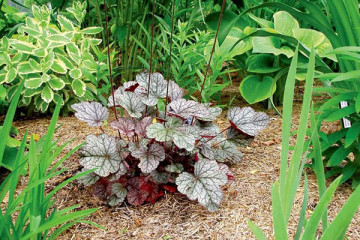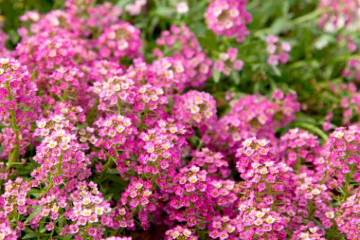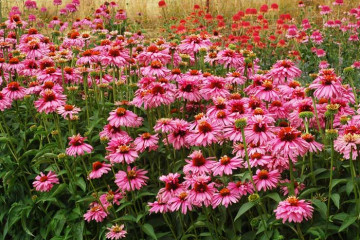Arends's Saxifrage - Purple, Floral Carpet
Content:
Arends' saxifrage is a herbaceous perennial plant that is very popular with gardeners and botanists. Green beauty with bright splashes can be found both in city flower beds and on alpine hills. What is the reason for such a demand and features of the plant, read on.
Popular varieties of Arends saxifrage
This rhizome plant, which can grow up to 70 cm high, is characterized by:
- creeping stems;
- branched root system;
- pronounced basal rosette;
- fleshy and leathery leaves.
The described plant has several subspecies, which differ mainly only in the color palette. All can boast of resistance to cold and unpretentious care. Among the most popular varieties are:
- Flamingo. According to the name, it has a pale pink color of the buds;
- White carpet (Whithe Carpet). Small inflorescences with snow-white bells bloom above the dark green shoots. The maximum diameter is 1 cm;
- saxifrage Purple Carpet (Pink carpet, Purple Carpet). Probably the most beautiful and noble of the above. The purple saxifrage has an aristocratic burgundy color with a yellow core;
- Floral Carpet is a very popular and beautiful plant, which is distinguished by delicate white-pink shades.
Saxifrage A flower carpet covers the earth with graceful petals. Therefore, it is not surprising that all subspecies are very often used for exterior design, especially landscapes.
Use in landscape design
Arends' saxifrage is very often used in landscape design for several reasons:
- unpretentiousness;
- the ability to grow where most plants die;
- beautiful ensemble with other plants.
Seedlings are used to decorate rock gardens. It looks harmoniously with artificial embankments, therefore it is used as an element of eco-design. The juicy green tone of the leaf plates in the ensemble with contrasting inflorescences fills the territory of the empty garden favorably.
Reproduction and planting
When planting and reproducing Arends' saxifrage, there are no special differences from other plants. You can grow flowers both on stony, depleted soil, and on fertile, well-fertilized.
It can grow both in the shade and in direct sunlight. The plant does not have any special whims, however, the only item that needs to be done regularly is watering.
Growing toArends' amnesia from seed
In order for an amazing plant to bloom and delight its owners for a long time, certain rules must be followed when growing it from seeds.
Before sowing seeds, they need to be stratified. This is done for better germination. This procedure is performed in the following way:
- Mix the seeds with sand.
- Place the mixture in the refrigerator for two to three weeks.
Then you need to plant seeds in seedlings. Further actions look like this:
- Prepare containers with special mixture.
- Scald the soil with boiling water.
- Spread the seeds mixed with sand on the surface.
- Spray and cover the crops with foil, do not sprinkle with earth.
If all these actions are done correctly, then in 7-10 days Arends's saxifrage will give its first shoots. After that, the matured specimens with small leaves dive into peat pots.
Vegetative propagation
To grow a plant in this way, various factors must be taken into account. However, the method is quite easy and fast. To get good bushes, it is recommended:
- Cut off a rooted shoot or shoot with aerial roots.
- Transplant to a new place with a clod of earth.
Shoots that are longer than 5 cm are later propagated by cuttings: they are divided into several parts. The plant should be rooted in water or peat soil, but this should be done indoors.
Transplanting seedlings into open ground
It is very easy to plant Arends' saxifrage in open ground. You need to find the right place for her.
- if it is an area with abundant sun rays, then it is important to carry out regular moisturizing;
- in the case of partial shade, no special care is required.
It is customary to plant a plant in open ground in early June, when the seedlings are already strong enough. After planting, for the first time, Arends's saxifrage grows shoots, after which it blooms only after a year. The main thing is to choose the right soil that will provide the plant with all the necessary nutrients.
Features of caring for Arends' saxifrage
Despite the praised unpretentiousness and simplicity, the saxifrage still requires some attention to itself for abundant flowering. A few recommendations on how to care for a vaunted plant.
Choosing a place - sun or shade
Arends' saxifrage feels great both under the aggressive sun and in partial shade. However, it must be remembered that a long stay of a plant in the shade can have a detrimental effect on its condition.
Soil and fertilizers
Arendsa prefers light soils:
- loose constitution;
- low connectivity;
- easy workability.
One of the main factors when choosing a soil is the presence of limestone, which has a very beneficial effect on the condition of the plant, fertility and good drainage.
Although soil fertility is one of the main factors, you should not get carried away with fertilizers. The abundance of nutrients is detrimental and detrimental. Everything is good that in moderation.
Watering and humidity
The saxifrage is very fond of water. Watering should be done in moderation, since stagnant moisture destroys the roots of the plant. When planting in advance, it is worth organizing the drainage of excess water from the root system, ensuring drainage.
The saxifrage also has its own requirements regarding the temperature regime. This noble plant does not survive at temperatures above 20 ° C. Surviving the winter is not a problem, but the heat can provoke many serious ailments and the reproduction of pests.
Possible difficulties and problems when growing
The plant is not too whimsical to care for and is very resistant to different types of pests.But improper watering, excessive fertilization and too high temperatures can cause disease.
Pests
The most common pests of Arends' saxifrage are:
- spider mite, which appears exclusively during drought. Yellowed leaves and curtains, entangled with whitish cobwebs, become signs of a tick;
- green aphids appear as a sticky black bloom on stems and leaves, which is very dangerous for saxifrage;
- worms are pests that cover the entire plant and eat it. They can be collected manually, or you can use special solutions to destroy them;
- thrips are pests that also eat the plant. Signs of this pest are white spots on the leaves.
In the fight against parasites, it is worth using insecticides.
Diseases
Arends' saxifrage is rarely susceptible to disease, but with poor care it can still happen. Although the plant loves moisture, it can also be a big problem. Abundant moisture can lead to the development of various fungi and rot, which leads to the complete death of the plant. This is the result of a lot of stagnant water in the soil that has poor drainage. To save a plant that has just begun to rot, you need to dig it out by the roots and cut off the decayed areas.
Prophylaxis
Diseases can be treated in various ways, but it is much easier to prevent their development. For this, it is important to remember that even the most moisture-loving plant can die from a large amount of water. To treat the most common diseases such as fungi and rotting, you need to carefully examine the plant affected by the disease and carefully separate the damaged parts. There are also some remedies that help very well in the destruction of the fungus (HOM, topaz, etc.).
Arends' saxifrage is a flower for all occasions: both practical to use at home and beautiful for design. If all the conditions are followed correctly, the plant will delight residents and guests with a variegated lush color.






















